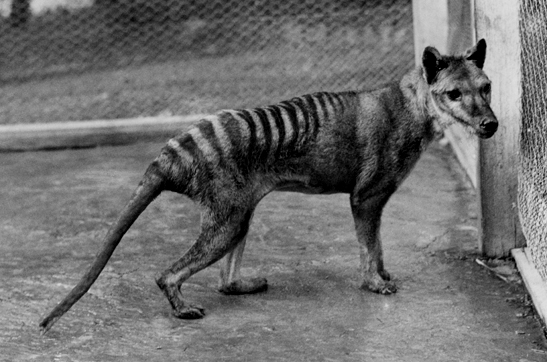
A molecular quirk led to the Tasmanian tiger and the wolf evolving to look more like twins than mammalian cousins, University of Melbourne bioscientists have found.
The Tasmanian tiger, or thylacine, was one of Australia's most enigmatic native species and was the only marsupial predator to survive into modern times. The thylacine became extinct as a result of being hunted and the last thylacine died in a zoo in 1936.
The thylacine was an uncanny animal, with a kangaroo's pouch and tiger stripes, but was perhaps best known, though, for its wolf-like body. Despite sharing a last common ancestor 160 million years ago, the thylacine and wolves independently evolved to look strikingly similar and had nearly identical skull shapes. There is even evidence that both species filled similar ecological niches.
A new paper by Dr Charles Feigin and Professor Andrew Pask has now confirmed that the resemblance between the thylacine and wolf isn't just skin deep.
Professor Pask's team at the University of Melbourne originally investigated links between the Tasmanian tiger and the wolf in a 2018 paper, where they sequenced the DNA of thylacine from a joey in order to probe their genes for DNA that contain the instructions for building proteins. However, their analysis of protein-coding genes revealed little evidence of molecular similarities.
Published in the journal Genome Research, their new study (Widespread cis-regulatory convergence between the extinct Tasmanian tiger and gray wolf), compared the rates of evolution across the genomes of 61 vertebrate species, leading to the discovery of hundreds of 'non-coding' DNA elements in the thylacine and wolf.
"Non-coding regions of the genome were once considered 'junk DNA', but we now know that they play vital roles during development," said Dr Feigin.
Non-coding DNA elements perform a distinct, but no less essential function to that of genes. Rather than acting as a blueprint for proteins, these elements act as control regions that determine when, where and how much a given protein-coding gene is active. Many of these elements showed signs of natural selection in both the thylacine and wolf and were particularly common in DNA regions important for the development of the skull and brain.
Professor Pask said: "This was a surprising finding which reveals a lot about how animals evolve and sheds more light on the fascinating biology of the unique Tasmanian tiger marsupial."
More on Pursuit.






